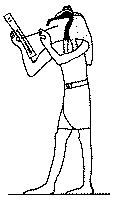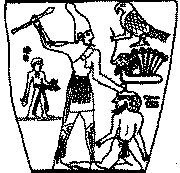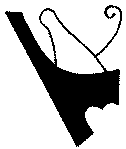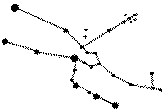Ancient Egyptians and the Constellations: Part 13
Thoth: the Small Pharaoh
The small Pharaoh figure indicated in the procession below, behind the Four Standards, can be identified by the lotus plants he is carrying and also by the hieroglyphs in front of his head.
The hieroglyphs sound out the name of "Toth", also spelt "Thoth". The pincers sign signifies the sound "th" while the mound sign signifies the sound "t". This further confirms that there is no way that the invention of writing can be credited to the Sumerians a thousand years later! (See Part 12)
Thoth was second only to Osiris in the Osiris Legend. (See Part 4)

Ancient Egyptian hieroglyphs were well established by 4468BCE!
Thoth is identified by the hieroglyphs of the pincers and the mound.
The pincers sign signifies the sound "th" while the mound sign signifies the sound "t".
The legend of Osiris begins with Thoth, who was credited with having introduced all the arts and sciences, including astronomy and hieroglyphs, to the Ancient Egyptians. He was also the spokesman, or messenger, of the gods and the keeper of their records. Thoth's Master was Osiris, as verified in the above segment from the Nermer Plate.
"Thoth" is actually the Graeco-Roman form of the Egyptian name "Djehuti"… or so it has been thought until now! It is clear from the Nermer Plate that the name "Thoth" was established well before 4468BCE (the dating of the Plate) and that it belongs to the era of the remote Ancient Egyptians. It was merely adopted by the Graeco-Romans.
Thoth is represented on the Nermer Plate in fully human form as a god, and by association a constellation or planet. This brings to the fore the noticeable fact that on the Nermer Plate the gods/deities, and by association the constellations or planets they represent, are not symbolized by human figures with the heads of birds or animals … as they are, for example, on Ancient Egyptian tombs.
The idea is generally espoused that the Ancient Egyptian gods with the heads of birds or animals belonged to a very ancient period, which was represented by totems. The theory goes that gradually these totems were the basis for the later Egyptian religion. However, it would seem from the Nermer Plate that the process was the other way round. That is, the human form preceded the totem form.
In Ancient Egyptian art Thoth was usually represented as an ibis bird or a baboon. In addition, because he was regarded as the moon god he was sometimes seen represented together with a winged moon. In legend Thoth had played a game of draughts with the moon and won from him a seventy-second part of his light, from which he created an extra five days in the year. Prior to that time there were 360 days in the Ancient Egyptian Calendar.


it is not difficult to work out
why he was given this role!
the product of
sophisticated thinkers.
The number seventy-two is significant in terms of astronomy since the sky bodies appear to move through one degree of their cycle over a period of seventy-two years.
It was no coincidence that the original number of days in an Ancient Egyptian year was identical to the number of degrees in a circle; i.e. 360. The Thoth legend encodes the knowledge of Precession by the specific reference to the numbers 360 and 72. When the number 72 is multiplied by the extra 5 days in the year gained by Thoth in the game of draughts with the Moon, the result is 360, the number of degrees in a circle.
Finally, when the seventy-two years are multiplied by the three hundred and sixty degrees of the complete cycle, we discover that it takes is 25,920 years for each heavenly cycle to be completed … at which time the process starts all over again. This cycle is referred to as Precession.
represents the concept of Precession.
Giant wearing the Red Crown
The Giant on Side Two of the Nermer Plate is certainly not portrayed in the same powerful stance as he was on Side One. (See Part 9) Possibly this is because his identity as the Orion figure has already been established.


That the Giant on Side two is the Nermer/Orion/Osiris portrayed on Side One is indicated in several ways. Firstly by the hieroglyphs of the catfish and the chisel to the front of his head, which translate into the name "Nermer". Secondly he is a Giant and his mode of dress to the lower half of his body correlates fairly well. Thirdly he is sporting the Osiris Beard. Fourthly Thoth attends him, and Osiris was Thoth's Master. Fifthly Sirius, the King of the Seven Stars, who also accompanied the Giant on Side One, attends him. Finally he is carrying the Orion Club.
However there is one noticeable difference about the two Giants: they are wearing different crowns! The Giant on Side One is wearing the White Crown while the Giant on Side Two is wearing the Red Crown.
It was noted earlier in Part 9 that the White Crown was a symbol of Precession. It has now evolved that a possible further purpose of the crown, White or Red, is to symbolize a Season and/or Age in the Precession Cycle.
Pursuing this logic the White Crown would signify the Zodiacal Season of Leo in which the Age of Gemini is the Third Month, while the Red Crown would signify both the Zodiacal Season of Taurus and its First Month, the Age of Taurus. Part 5)


the Zodiacal season of Leo
the Zodiacal Season of Taurus
Notice how the Red Crown looks like a throne with a curled horn sitting upon it; not unlike Taurus the Bull sitting on his throne. The Bull imagery is carried through in the colour red. You need look no further than Spain, in the bullring, for evidence of the association of the colour red with the Bull. In the Bullring the Matador and the Bull are re-enacting the Dawn of the Age of Taurus, a ritual inherited from the Ancient Egyptians. The "Bull" represents Taurus while the "Ring" represents both the Sun and the Portal to the New Age. (More on this later.) Indeed the Dawn of the Age of Taurus would be the interpretation of any myths or legends in which the colours of red and white play a dominant part.
This Taurean imagery is supported in the figure of the Giant Nermer on Side Two of the Nermer Plate. Apart from him wearing the Taurean Red Crown he has also transferred the Orion Club to his left hand. (A situation which gives rise to the question as to whether the Giant is right-handed, left-handed or ambidextrous!) Handled in this position the club has highly sexual connotations linked to the Taurus the Bull imagery of the uncastrated male, the leader and propagator of the herd. The Giant Nermer, in effecting the image of Taurus the Bull, symbolically becomes Taurus the Bull, the New Zodiacal Season and Age.

The Giant Nermer effecting the image
of Taurus the Bull
The analogy of the Red Crown as the throne of both the New Season and the New Age of Taurus is confirmed in the stars … in the constellation of Orion's Chair, which is directly below the constellation of Orion. When the constellation of Orion's Chair is rotated 90 degrees the Red Crown becomes evident. The Age of Taurus is seated upon the Throne of Orion!


















